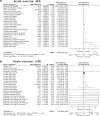A Systematic Review and Meta-Analysis on the Effects of Exercise on the Endocannabinoid System
- PMID: 34870469
- PMCID: PMC9418357
- DOI: 10.1089/can.2021.0113
A Systematic Review and Meta-Analysis on the Effects of Exercise on the Endocannabinoid System
Abstract
Introduction: The endocannabinoid (eCB) system plays a key role in maintaining homeostasis, including the regulation of metabolism and stress responses. Chronic stress may blunt eCB signaling, and disruptions in eCB signaling have been linked to stress-related psychiatric disorders and physical health conditions, including anxiety, depression, post-traumatic stress disorder (PTSD), diabetes, and obesity. Pharmacological and nonpharmacological behavioral interventions (e.g., exercise) that target the eCB system may be promising therapeutic approaches for the prevention and treatment of stress-related diseases. In this study, we perform a systematic review and the first meta-analysis to examine the impact of exercise on circulating eCB concentrations. Materials and Methods: We performed a review of the MEDLINE (PubMed) database for original articles examining the impact of exercise on eCBs in humans and animal models. A total of 262 articles were screened for initial inclusion. Results: Thirty-three articles (reporting on 57 samples) were included in the systematic review and 10 were included in the meta-analysis. The majority of samples that measured anandamide (AEA) showed a significant increase in AEA concentrations following acute exercise (74.4%), whereas effects on 2-arachidonoylglycerol (2-AG) were inconsistent. The meta-analysis, however, revealed a consistent increase in both AEA and 2-AG following acute exercise across modalities (e.g., running, cycling), species (e.g., humans, mice), and in those with and without pre-existing health conditions (e.g., PTSD, depression). There was substantial heterogeneity in the magnitude of the effect across studies, which may relate to exercise intensity, physical fitness, timing of measurement, and/or fasted state. Effects of chronic exercise were inconsistent. Conclusions: Potential interpretations and implications of exercise-induced mobilization of eCBs are discussed, including refilling of energy stores and mediating analgesic and mood elevating effects of exercise. We also offer recommendations for future work and discuss therapeutic implications for exercise in the prevention and treatment of stress-related psychopathology.
Keywords: anandamide; endocannabinoids; mental health; physical activity; running.
Conflict of interest statement
No competing financial interests exist.
Figures



Similar articles
-
Circulating endocannabinoids and psychological outcomes in women with PTSD.J Anxiety Disord. 2023 Jan;93:102656. doi: 10.1016/j.janxdis.2022.102656. Epub 2022 Nov 23. J Anxiety Disord. 2023. PMID: 36469982 Free PMC article.
-
Reductions in circulating endocannabinoid levels in individuals with post-traumatic stress disorder following exposure to the World Trade Center attacks.Psychoneuroendocrinology. 2013 Dec;38(12):2952-61. doi: 10.1016/j.psyneuen.2013.08.004. Epub 2013 Sep 10. Psychoneuroendocrinology. 2013. PMID: 24035186 Free PMC article.
-
Loss of exercise- and stress-induced increases in circulating 2-arachidonoylglycerol concentrations in adults with chronic PTSD.Biol Psychol. 2019 Jul;145:1-7. doi: 10.1016/j.biopsycho.2019.04.002. Epub 2019 Apr 9. Biol Psychol. 2019. PMID: 30978371
-
Cannabinoids as therapeutics for PTSD.Pharmacol Ther. 2020 Jul;211:107551. doi: 10.1016/j.pharmthera.2020.107551. Epub 2020 Apr 18. Pharmacol Ther. 2020. PMID: 32311373 Review.
-
Neurobiological Interactions Between Stress and the Endocannabinoid System.Neuropsychopharmacology. 2016 Jan;41(1):80-102. doi: 10.1038/npp.2015.166. Epub 2015 Jun 12. Neuropsychopharmacology. 2016. PMID: 26068727 Free PMC article. Review.
Cited by
-
Effects of exercise of different intensities on withdrawal symptoms among people with substance use disorder: a systematic review and meta-analysis.Front Physiol. 2023 May 10;14:1126777. doi: 10.3389/fphys.2023.1126777. eCollection 2023. Front Physiol. 2023. PMID: 37234417 Free PMC article.
-
Alterations of the endocannabinoid system in adolescents with non-suicidal self-injury as a function of childhood maltreatment.Transl Psychiatry. 2024 Dec 18;14(1):491. doi: 10.1038/s41398-024-03205-2. Transl Psychiatry. 2024. PMID: 39695136 Free PMC article.
-
Circulating endocannabinoids and psychological outcomes in women with PTSD.J Anxiety Disord. 2023 Jan;93:102656. doi: 10.1016/j.janxdis.2022.102656. Epub 2022 Nov 23. J Anxiety Disord. 2023. PMID: 36469982 Free PMC article.
-
Fractional amplitude of low-frequency fluctuations associated with μ-opioid and dopamine receptor distributions in the central nervous system after high-intensity exercise bouts.Front Neuroimaging. 2024 Feb 22;3:1332384. doi: 10.3389/fnimg.2024.1332384. eCollection 2024. Front Neuroimaging. 2024. PMID: 38455686 Free PMC article.
-
Endurance Exercise Training Alters Lipidomic Profiles of Plasma and Eight Tissues in Rats: a MoTrPAC study.Res Sq [Preprint]. 2024 Nov 21:rs.3.rs-5263273. doi: 10.21203/rs.3.rs-5263273/v1. Res Sq. 2024. PMID: 39606465 Free PMC article. Preprint.
References
Publication types
MeSH terms
Substances
LinkOut - more resources
Full Text Sources
Medical

